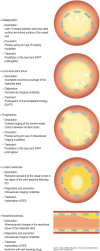Coronary Stent Thrombosis- Predictors and Prevention
- PMID: 32605709
- PMCID: PMC7358792
- DOI: 10.3238/arztebl.2020.0320
Coronary Stent Thrombosis- Predictors and Prevention
Abstract
Background: Stent thrombosis (ST) is a dreaded complication after stent implantation and is associated with a mortality between 5% and 45%. The mechanisms by which ST arises are complex. Because of the seriousness of this situation, all phy - sicians should have at least basic knowledge of it. In this article, we present the risk factors for ST and discuss some innovative approaches to its treatment.
Methods: This review is based on pertinent articles retrieved by a selective search in PubMed, and on current international guidelines and expert recommendations.
Results: The frequency of ST has been markedly lowered by technical advances in coronary stenting and by the implementation of modern implantation techniques, including the introduction of coverage with dual antiplatelet therapy (DAPT). Both patient-related risk factors and procedural aspects can elevate the risk of ST. The independent risk factors for ST include premature termination of DAPT (hazard ratio [HR] 26.8; 95% confidence interval [8.4; 85.4]; p <0.0001), malignant disease (odds ratio [OR]: 17.45; [4.67; 65.26]; p <0.0001), and diabetes mellitus (OR: 3.14; [1.33; 7.45]; p = 0.0093). In comparison to angiographically guided procedures, the use of intracoronary imaging techniques in patients with acute coronary syndrome lowers the frequency of ST (0.6% versus 1.2%; p = 0.005). These techniques enable the detection of many findings in the coronary arteries that are associated with the development of ST. In such cases, countermeasures such as secondary stent dilatation or prolongation of DAPT can help prevent ST.
Conclusion: As the pathophysiology of ST is multifactorial, research in this area presents a special challenge. Prospective clinical trials will be needed to determine whether the systematic use of imaging techniques can lower the frequency of ST.
Figures


References
-
- Claessen BE, Henriques JP, Jaffer FA, Mehran R, Piek JJ, Dangas GD. Stent thrombosis: a clinical perspective. JACC Cardiovasc Interv. 2014;7:1081–1092. - PubMed
-
- Iakovou I, Schmidt T, Bonizzoni E, et al. Incidence, predictors, and outcome of thrombosis after successful implantation of drug-eluting stents. JAMA. 2005;293:2126–2130. - PubMed
-
- Lemesle G, Tricot O, Meurice T, et al. Incident myocardial infarction and very late stent thrombosis in outpatients with stable coronary artery disease. J Am Coll Cardiol. 2017;69:2149–2156. - PubMed
-
- Cutlip DE, Windecker S, Mehran R, et al. Clinical end points in coronary stent trials: a case for standardized definitions. Circulation. 2007;115:2344–2351. - PubMed
-
- D‘Ascenzo F, Bollati M, Clementi F, et al. Incidence and predictors of coronary stent thrombosis: evidence from an international collaborative meta-analysis including 30 studies, 221,066 patients, and 4276 thromboses. Int J Cardiol. 2013;167:575–584. - PubMed
Publication types
MeSH terms
LinkOut - more resources
Full Text Sources
Research Materials

